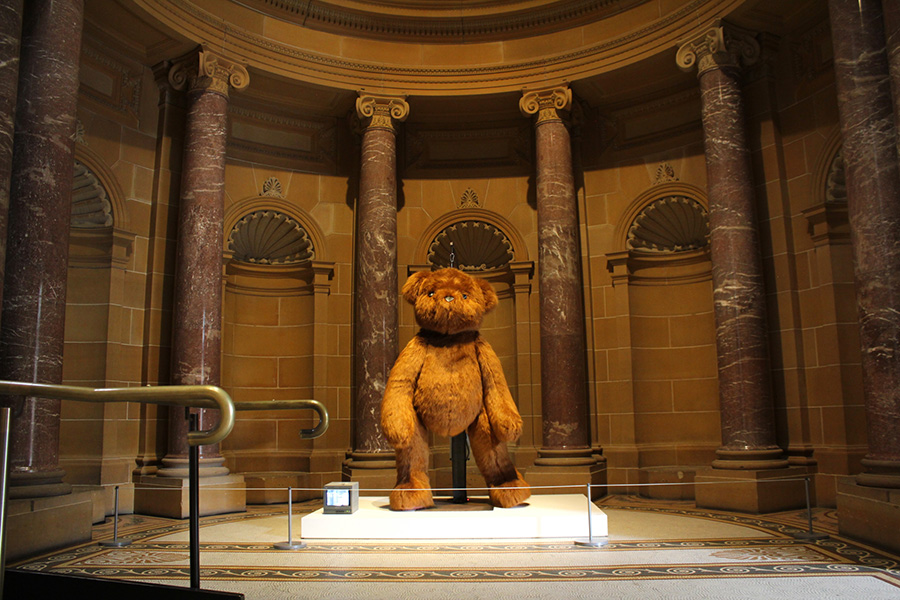For EJ Son, the world hovers on the edge of peril, excess and delight: what we seek to repress returns in lurid and exuberant form.
— Patrice Sharkey
Image: EJ Son, Dancing Teddy, 2023, installation view. Presented in the Wynne Prize, Art Gallery of NSW, Sydney, 2024. Image courtesy of the artist.
EJ Son
For EJ Son, the world hovers on the edge of peril, excess and delight: what we seek to repress returns in lurid and exuberant form.
Working across sculpture, installation, video, ceramics and new media, Son holds a Bachelor of Visual Arts (Honours) from Sydney College of the Arts (2018). At its core, their practice possesses a sensorial charge that unfolds at the intersection of intimacy and spectacle, shame and desire.
In the sculptural light work Titty Tree (2021), for example, Son transforms 444 silicone casts of capsicum and tomato bases into nipple-like flowers—a radiant, slightly absurd totem to bodily acceptance and intergenerational love, inspired by a memorable encounter with the artist’s grandmother in Korea. In the depths of a brutal winter, Son, newly committed to a rejection of bras, was met with laughter and curiosity:
“As I took my coat off my grandmother’s eyes caught my hardened nipples piercing through my layers. She burst out laughing and asked to take a look. Hesitant, but as one might offer their palms to a fortune teller, I leaned in so she could take a closer look at my stretched sweater. She cackled louder, ‘Just like your mother! They’ll bring you a good husband—just like your father!’”
By contrast, Fountain (2025)—a monumental installation of twelve inward-facing toilets whose synchronised jets converge in a climactic, cathartic gush—proposes a metaphorical cure for what the artist calls the “constipated heart”: a clenched soul resisting release.
Within psychoanalytic theory, the abject refers to the parts of the self that must be expelled to preserve identity—substances and sensations cast out from the body, of us yet no longer recognisable as such. Abjection disturbs the neat binaries of inside and outside, self and other. It is within this ambiguous terrain that Son’s practice thrives, embracing instability and overflow as strategies for reconfiguring contemporary notions of power, gender and identity.
Born in South Korea and raised in Australia, Son’s understanding of self equally navigates the fluid boundaries of cultural belonging. Recent exhibitions, including Piece of Cake (2025) at Openspace Bae, signal the artist’s deepening dialogue with Korean diasporic communities. Site-responsive works created in the city of Busan—such as Nodding Buddha (2025), a kinetic shrine of bobbing plastic idols accompanied by a working bug zapper—highlight contemporary tensions between spirituality, devotion, capitalism and desire.
Perhaps Son’s most recognisable work, Dancing Teddy (2022–ongoing) is a comedically oversized teddy bear fitted with a live camera in its eye, swaying gently from side to side. Oscillating between the endearing and the uncanny, the work implicates the viewer in a choreography of watching and being watched. Inspired by the Korean television program I Live Alone and the nation’s epidemic of hidden-camera crimes (molka), the bear, Son notes, “serves as a performer on my behalf,” embodying the compulsion “to be seen, and the fear of being forgotten.” In its most menacing iteration, presented for Dark Mofo (2023) and titled Giant Teddy, the bear’s eyes blazed with red laser light, cementing itself as a disconcerting allegory for visibility, surveillance and coherence in the attention economy.
Across Son’s work a sense of porousness is undeniable. They ask what it means to exist when every act of self-exposure risks consumption, and yet to remain unseen feels like erasure. Within this schism, Son locates a form of freedom—a shape-shifting practice that leaks, sways, crackles and glows with the messy brilliance of being alive.
Essay written by Patrice Sharkey, October 2025.
Patrice Sharkey is an independent curator and writer who lives on Wurundjeri Land in Naarm/Melbourne.

